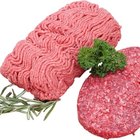
You're not likely to find silverside in the U.S., unless you go to a specialty butcher, but not to worry. Several lean, inexpensive cuts of meat make fine substitutes. Use silverside and its alternatives for hearty, slow-cooked stews and soups, or soak it in a brine for several days to make corned beef. Lean and nutritious, silverside is a good choice for family meals on a budget.
Cooking Methods
Silverside is cut from the lower portion of the steer, directly above the back leg muscles. This inexpensive cut of meat is flavorful, but rather tough. Traditionally, silverside is prepared by corning it, although any slow braising method works. Simmer it gently in a pot on low or cook it in a slow cooker to ensure a tender, flavorful meal. A packet of dressing and seasoning mix stirred into the cookpot will add flavor to the meat as the extended low-temperature cooking tenderizes it.
Buying Silverside
While you'll find silverside roasts in many countries across the globe, in the U.S., look for bottom round roasts or brisket as a comparable alternative. Buy roasts that have small flecks of white throughout. While this cut is naturally lean, a bit of fat will tenderize it and give it flavor. Avoid those that have thick ropes of yellowish fat. Ask the butcher to remove the silvery membrane that runs along the length of the meat and is too tough to eat.
Nutrition
Beef has a reputation for being a fat-filled, artery-clogging food, but lean cuts, such as silverside beef, are a good choice for healthy eating. Silverside beef, or bottom round, has 4.9 g of fat per 3 oz. serving, and 23 g of protein. It's also a good source of iron, zinc, thiamin and niacin.
Food Safety
When buying silverside, or any other beef cut, buy it right before you leave the store. Refrigerate the beef immediately and use it within three or four days, or freeze it for six to 12 months. Raw meat may contain pathogens that can cause illness. When cooking silverside, use clean knives and cutting boards and wash them thoroughly after use to avoid contaminating other foods.
Related Articles

Do Filet Mignon Steaks Come From Female ...

How Long After Buying a Beef Roast Is ...
What Cuts of Beef Come From a Hind?

How to Convection Roast a Brisket

How to Cook Angus Beef in the Oven

What Is a Tip Roast?

How Long Can Beef Brisket Be ...

How to Make a Blackbuck Antelope Roast

Different Cuts of Steak

What Cuts of Meat Are Used for Ground ...

What Is a Chateau Cut?

How to Tell If a Pork Roast is Done
What Part of the Cow Is Boneless Beef ...

How to Cook Silverside on a Stove Top

Brisket vs. Tri-Tips

How to Store Cooked Ground Beef

How to Buy Oxtail

What Is the Safe Cooking Temp for a ...

How to Cut Up Your Deer Tenderloins

How to Cook Beef for Shredding
References
- "Lobel's Meat Bible"; Stanley Lobel, et al.; 2009
Writer Bio
Julie Christensen is a food writer, caterer, and mom-chef. She's the creator of MarmaladeMom.org, dedicated to family fun and delicious food, and released a book titled "More Than Pot Roast: Fast, Fresh Slow Cooker Recipes."
Photo Credits
Alexandra Grablewski/Lifesize/Getty Images